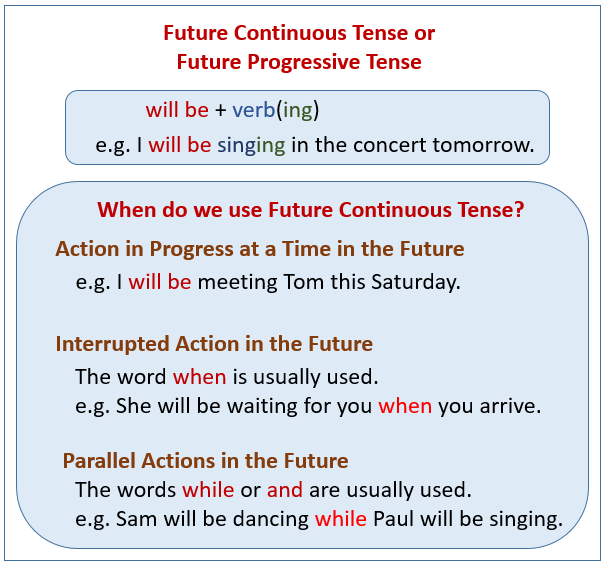Future Continuous Tense
Related Pages
Future Tense
Future Perfect
Present Continuous Tense
Past Continuous Tense
IELTS, TOEFL And English As A Second Language
More Lessons On English Grammar
In these lessons, we will learn
- how to form the Future Continuous Tense
- when to use the Future Continuous Tense
- how to form the negatives in Future Continuous Tense
- the differences between Future Continuous, Future Perfect and Future Perfect Continuous Tenses
Verbs have different forms, called tenses. The tense of a verb tells us when the action happens.
The following diagram shows examples of when to use the Future Continuous Tense.

Forms of Future Continuous Tense
The future continuous tense is used to describe a future action. will be + present participle = future continuous
Examples:
I will be having a party for my birthday.
We will be leaving in ten minutes.
She will be waiting at the gate.
When do we use the Future Continuous Tense?
We use the future continuous tense to describe a future action that will happen over a period of time. The future continuous tense is also called the future progressive tense.
Examples:
I will be meeting Susan this weekend.
They will be coming to see us soon.
We often use the future continuous together with the simple present in the same sentence. The word when is usually used.
Examples:
I will be waiting for you when your train arrives.
She will be working when the celebration starts.
We can use the word while to indicate two parallel actions that are happening at the same time.
Examples:
At the concert tomorrow, Ben will be singing while Sarah will be dancing.
I will be working hard next week while you will be relaxing on the beach.
Negative Forms of Future Continuous Tense
We form the negative by adding not after will.
will + not + be + present participle
Contraction (or short form):
will not = won’t
Examples:
We will not be going back there again.
We won’t be going back there again.
I will not be using the computer for the next few hours.
I won’t be using the computer for the next few hours.
Structure and use of the future continuous tense
The future continuous is formed with the subject, the auxiliary verb ‘will’ or ‘be going to’,
the verb ’to be’ and the main verb with gerund (-ing). It is used to express interrupted
actions in the future, parallel actions in the future, and a sense of atmosphere in the future.
How to conjugate the verb “make” in the future continuous tense?
The future continuous tense is used to describe a future action.
Some examples of the future continuous tense.
How to use the Future Progressive structure to communicate a future action?
English grammar has several ways to communicate future action.
Examples:
Present progressive with future intentions: I am going to Paris, next week.
Simple Future: I will go to Paris, next week.
Infinite with intention: I am going to go to Paris, …
Future Progressive: I will be going to Paris, …
The Future Continuous Tense
Future point in time
Something in progress during this time
Unfinished (between start and finish)
Will + be + verb-ing
Be going to + be + verb-ing
Examples:
When you get home tonight, I’m going to be cooking dinner.
When class finished, it will still be raining.
Future Continuous vs Future Perfect vs Future Perfect Continuous Tenses
This video shows you how and when to use the Future Continuous, Future Perfect and Future
Perfect Continuous when speaking English.
Future Continuous: I will be playing
Future Perfect: I will have played
Future Perfect Continuous: I will have been playing.
Forms and uses of the future progressive, future perfect, and future perfect progressive
Use the future perfect for future actions or events that will finish before a certain point in time.
Use the future progressive to express how long an event or action will be in progress up to a certain
point in time.
Use the future perfect progressive to express the duration of an action that will be in progress up
to a future point in time. We do not normally use non-action verbs in progressive forms.
The future perfect uses will have + past participle.
The future perfect progressive uses will have been + present participle.
Try the free Mathway calculator and
problem solver below to practice various math topics. Try the given examples, or type in your own
problem and check your answer with the step-by-step explanations.

We welcome your feedback, comments and questions about this site or page. Please submit your feedback or enquiries via our Feedback page.